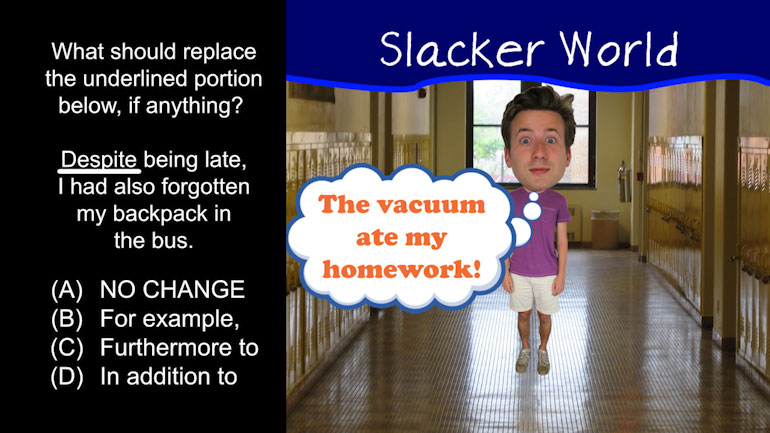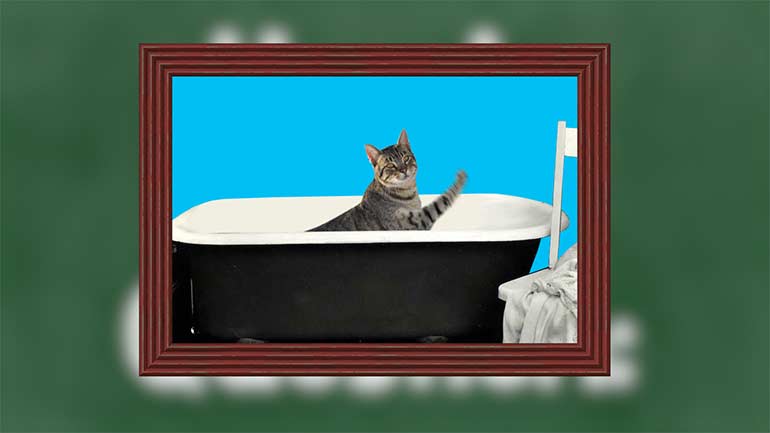ShmoopTube
Where Monty Python meets your 10th grade teacher.
Search Thousands of Shmoop Videos
Rhetorical Skills Videos 50 videos
ACT English: Passage Drill 2, Problem 11. Which of the following sentences would make the most effective transition?
In this ACT English passage drill determine if the writer of the passage may or may not have achieved their proposed goal.
ACT English: Passage Drill Drill 3, Problem 2. What would the paragraph lose if the writer omits the underlined phrase?
ACT English 1.5 Passage Drill 220 Views
Share It!
Description:
ACT English: Passage Drill 1, Problem 5. What is the best, most concise way to express the underlined portion?
Transcript
- 00:04
Here's your Shmoop du jour, brought to you by coconut shells. They go great with a grass skirt.
- 00:23
How would you correct this underlined segment from the passage, if at all?
- 00:27
cover that is enclosing
- 00:30
And here are the potential answers:
- 00:33
The word "that" frequently inflicts wordiness on innocent sentences.
Full Transcript
- 00:36
If a sentence works without it, it's always best to leave it out.
- 00:40
We can eliminate choice (A) for this reason. "Cover that is enclosing" isn't the
- 00:46
most concise way to express this thought.
- 00:49
The "that" is making this poor sentence wordy when it doesn't need to be.
- 00:53
"That" causes problems in choice (C) as well. This choice also makes the mistake of
- 00:57
needlessly placing us in the future tense with the word "will."
- 01:01
The rest of the sentence is in the present tense, so shifting into the future tense for
- 01:05
no reason is inconsistent.
- 01:07
It's not like these coconut shells are only going to enclose coconuts on some day in the
- 01:11
future; they're doing it right now.
- 01:14
Choice (D) incorrectly makes "cover" the subject and "encloses" the verb. This sentence already
- 01:19
has a subject, "drupe," and a verb, "is."
- 01:25
All the other parts of the sentence should be working towards describing this "drupe"
- 01:29
and nothing else. There's no room for rival subjects and predicates here.
- 01:34
Choice (B) is the correct answer. For starters, it eliminates that troublemaking "that."
- 01:38
It also correctly applies the word "enclosing." In this form, "enclosing" is a participle,
- 01:44
which is a word derived from a verb that acts as an adjective by modifying a noun.
- 01:48
Here, the participle "enclosing" introduces a participle phrase that describes the coconut's
- 01:52
"hard stony cover."
- 01:54
But...while the coconut seems tough on the outside, inside he's a real softy
Related Videos
ACT English: Punctuation Drill 2, Problem 2. Where should the semi-colon be placed?
ACT English: Punctuation Drill 3, Problem 1. How should this sentence be changed so that it is grammatically correct?
ACT English: Punctuation Drill 3, Problem 2. How should we properly hyphenate the words in this sentence?
ACT English: Punctuation Drill 3, Problem 4. Which choice best formats this list of items?
ACT English: Punctuation Drill 2, Problem 1. Which choice of punctuation best completes the sentence?






















































